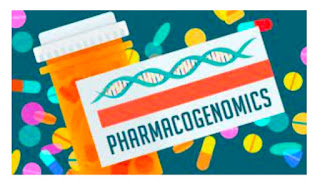PHARMACOGENOMICS
PHARMACOGENOMICS:
✓ Definition:
• Pharmacogenomics also called as pharmacogenetics.
• It is a field of research that studies how a person’s genes affect him or her and how he or she responds to medications.
• The long-term goal of pharmacogenomics is to help doctors select the drugs and doses which is best suited for each person.
• Pharmacogenomics combines traditional pharmaceutical sciences such as biochemistry with a knowledge of genes, proteins, and single nucleotide polymorphisms.
✓ History :
• Genomics was established by Fred Sanger when he sequenced the complete genomes of a virus and a mitochondrion.
• His group established techniques of sequencing, genome mapping, data storage, and bioinformatic analyses in the 1970-1980s.
• The actual term ‘genomics’ have been coined by Dr. Tom Roderick, a geneticist at the Jackson Laboratory (Bar Harbor, ME) over beer at a meeting held in Maryland on the mapping of the human genome in 1986.
✓ Importance of pharmacogenomics:
Pharmacogenomics eventually can lead to an overall decrease in the cost of health care because of decreases in:
(1) the number of adverse drug reactions
(2) the number of failed drug trials
(3) the time it takes to get a drug approved
(4) the length of time patients are on medication
(5) the number of medications patients must take to find an effective therapy
(6) the effects of a disease on the body (through early detection
✓ Benefits of pharmacogenomics:
• More powerful medicines.
• Better, safer drugs the first time.
• More accurate methods of determining appropriate drug dosages.
• Advanced screening for disease.
• Better vaccines.
• Improvements in the drug discovery and approval process.
• Decrease in the overall cost of health care.
✓ Barriers to pharmacogenomic process:
Pharmacogenomics is a developing research field that is still in its infancy.
Several of the following barriers will have to be overcome before many pharmacogenomics benefits can be realized. They are the followings.
• Complexity of finding gene variations that affect drug response.
• Disincentives for drug companies to make multiple pharmacogenomic products.
• Limited drug alternatives.
✓ Pharmacogenomics today
The cytochrome P450 (CYP) family of liver enzymes is responsible for breaking down more than 30 different classes of drugs. DNA variations in genes that code for these enzymes can influence their ability to metabolize certain drugs.
Less active or inactive forms of CYP enzymes that are unable to break down and efficiently eliminate drugs from the body can cause drug overdose in patients.
Today, clinical trials researchers use genetic tests for variations in cytochrome P450 genes to screen and monitor patients. In addition, many pharmaceutical companies screen their chemical compounds to see how well they are broken down by variant forms of CYP enzymes.
Another enzyme called TPMT (thiopurine methyltransferase) plays an important role in the chemotherapy treatment of a common childhood leukemia by breaking down thiopurines.
A small percentage of Caucasians have genetic variants that prevent them from producing an active form of this protein.
As a result, thiopurines elevate to toxic levels in the patient because the inactive form of TMPT is unable to break down the drug.
Today, doctors can use a genetic test to screen patients for this deficiency, and the TMPT activity is monitored to determine appropriate thiopurine dosage level.
✓ Pharmacogenomics in future:
New developments in this field will impact on drug design at three main levels
(1) the interaction of the drug with its receptor binding site.
(2) the absorption and distribution of the drug.
(3) the elimination of the drug from the body.
✓ Conclusions
• Pharmacogenomics in pharmaceutical industry is a potential tool, awaiting use for the maximum benefit.
• It represents a radical advance in medical history.
• The main aims of it are; personalized therapy, improvement in efficacy and reduction in adverse drug reactions, correlation of genotype with clinical genotype, identification of novel targets for new drugs, and pharmacogenetic profiling of patients to predict disease susceptibility and drug response.
• In the past, most drugs were designed to work on the population level rather than being targeted for the individual patient.
• By reversing that trend, pharmacogenomics helps to refine the focus of treatment and makes drugs more effective and less toxic.
• Rather than relying on the outward manifestation of disease – the signs and symptoms that physicians call the phenotype – pharmacogenomic medicine examines and treats the genotype.
• Gradual inclusion of pharmacogenomic studies in drug discovery and development will cause substantial reduction in the expenses involved in drug development, ensure a safe clinical trial and reduce failures.
• Thus, many potential drugs which may be lost due to the effects on the outliers in a study can be retained when pharmacogenomic study is used in the future.
✓ References:
1. Fiers W, Contreras R, Duerinck F, Haegeman G, Iserentant D, Merregaert J, Min Jou W, et al. Complete nucleotide sequence of bacteriophage MS2 RNA: primary and secondary structure of the replicase gene. Nature 1976;260(5551):500-507.
2. Sanger F, Air GM, Barrell BG, Brown NL, Coulson AR, Fiddes CA, Hutchison CA, et al. Nucleotide sequence of bacteriophage phi X174 DNA. Nature 1977;265(5596):687-695.
3. Min Jou W, Haegeman G, Ysebaert M, Fiers W. Nucleotide sequence of the gene coding for the bacteriophage MS2 coat protein. Nature 1972;237(5350):82-88.
4. The Viral Genomes Resource, NCBI Friday,14 September 2007.
5. Genome Project Statistic , NCBI Friday,14 September 2007.
6. American Medical Association home page on internet viewed on 10th January 2009
7. Emsley RA. Partial response to antipsychotic treatment: the patient with enduring symptoms. J Clin Psychiatry 1999;60 Suppl 23(10-13).
REHA NISHATH
B .PHARMACY
TRAINEE INTERN - BUSINESS DEVELOPMENT
CLINOSOL RESEARCH PRIVATE LIMITED







Comments